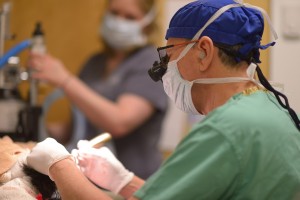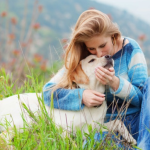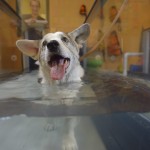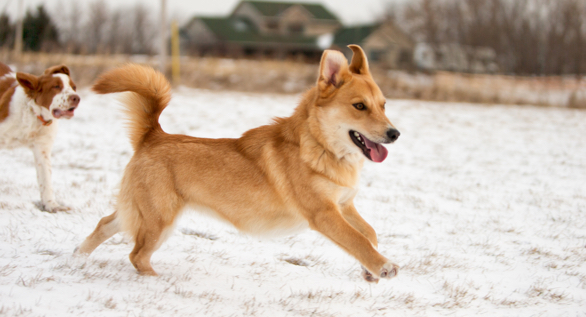February – Pet Dental Health Month
 February is Pet Dental Health Month, a time to reflect on an important health issue in our pets that often escapes our detection.
February is Pet Dental Health Month, a time to reflect on an important health issue in our pets that often escapes our detection.
1) Pets Are Genetically Programmed To Hide Pain & Disease
Everyone knows that one painful tooth can certainly ruin your whole day and mood. But did you know that smoldering periodontal disease is also a stressor on organ health, and that our pets rarely give clear signs of serious disease? Dogs and cats are genetically and behaviorally programmed to conceal their illness, so as not to ever appear weak or vulnerable. Of course there are some pets who, like people, will “complain” about oral disease, but mostly you will have no clues until there is severe oral malodor, bleeding, swelling of the face, tooth mobility, or even a spontaneously broken jaw due to insidious chronic loss of tooth supporting bone, or what is called periodontal disease.
2) 85% of Older Dogs & Cats Have Periodontal Disease
By 3 years of age about 85% of dogs and cats have some level of periodontal disease. This may also be accompanied by periodontitis, meaning inflammation and swelling of the gingiva (gums). Other times, inflammation is hidden under normal appearing gingiva and left untreated, the progression of bone loss can occur in just a few years. Most pet owners think there must be gingival recession visible before teeth can become loose or seriously diseased. In fact, of the four tissues that support a tooth, bone is the most labile or changeable and the one that can melt away the quickest from inflammation, even under normal looking gingiva!
3) 1/3 of Dogs Have Chipped or Fractured Teeth:
About a third of dogs have chipped or fractured teeth, often from aggressive chewing of hard materials. A fractured tooth is sensitive, and may expose the pulp cavity containing the live neurovascular supply. A deep fracture leads to tooth infection, and a tooth root abscess. Dental X-rays are required to diagnose this endodontic disease. Treatment is either extraction of the abscessed tooth and all roots or root canal therapy.
To fully diagnose dental disease, your veterinarian must perform dental probing and dental x-rays, just as your dentist does for you. With pets, this is done during carefully monitored anesthesia. Current drug protocols and monitoring procedures have made modern anesthesia extremely safe. Dr. Blazejewski performs many anesthetic procedures on old and medically fragile dogs and cats whose lives are totally transformed for the better after having their dental disease treated.






 Email
Email his Going to Burn? Side Effects of Radiation Therapy
his Going to Burn? Side Effects of Radiation Therapy
 Upon getting your pet home and settled, be sure to follow your vet’s instructions. Even if your dog hates crate rest, your vet’s advice should be followed. Same goes for cats who may be cranky about having their outside time restricted—while listening to your cat complain and scrabble at the door may seem like an avoidable annoyance, it may mean the difference between life and death, especially if post-surgery your vet has recommended
Upon getting your pet home and settled, be sure to follow your vet’s instructions. Even if your dog hates crate rest, your vet’s advice should be followed. Same goes for cats who may be cranky about having their outside time restricted—while listening to your cat complain and scrabble at the door may seem like an avoidable annoyance, it may mean the difference between life and death, especially if post-surgery your vet has recommended  At VRC we have a rehabilitation center designed to treat all your pet’s rehabilitation and recovery needs. We specialize in recovery from surgery and trauma, and pay attention to things such as weight management, pain management, and rehabilitative therapies. We offer a range of treatments including hydrotherapy, laser therapy, acupuncture, massage, therapeutic ultrasound, and exercise sessions in a canine-designed gym. We believe in the power of rehabilitation when it comes to improving your beloved pet’s strength, range of motion, and mobility. Just 25 miles outside of Philadelphia in Malvern, PA, at VRC you can expect a comprehensive plan for pain management in your pet as well as a holistic approach to his or her rehabilitation.
At VRC we have a rehabilitation center designed to treat all your pet’s rehabilitation and recovery needs. We specialize in recovery from surgery and trauma, and pay attention to things such as weight management, pain management, and rehabilitative therapies. We offer a range of treatments including hydrotherapy, laser therapy, acupuncture, massage, therapeutic ultrasound, and exercise sessions in a canine-designed gym. We believe in the power of rehabilitation when it comes to improving your beloved pet’s strength, range of motion, and mobility. Just 25 miles outside of Philadelphia in Malvern, PA, at VRC you can expect a comprehensive plan for pain management in your pet as well as a holistic approach to his or her rehabilitation.

